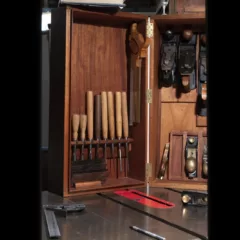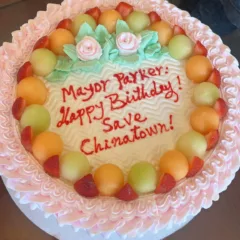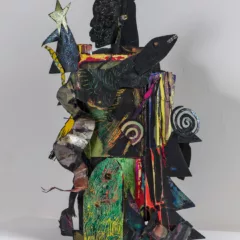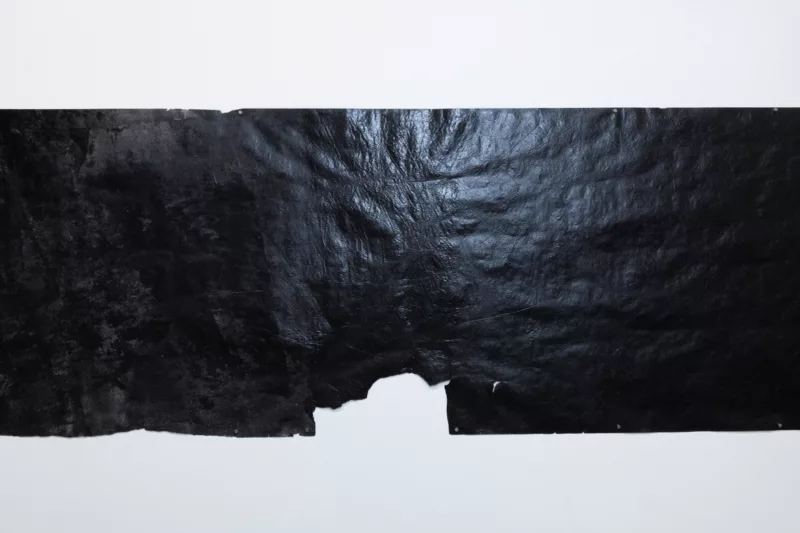
Photograph courtesy of Sam Fritch; Arcadia University
The exhibition of 37 works on paper at Arcadia University’s Spruance Gallery is a wonderful introduction to Quentin Morris’s riotously quiet work. Some are paintings on paper using a variety of liquid mediums, others are drawings using solid mediums on paper or on commercial mailers. All are black, and all are unique, even the ones that look similar. Morris eschews titles but acquiesces to dating the work. He has a system that appears reductive until you realize his collaborator is the biggest imp of all, chance. The result is a signal body of work and an opportunity to question your presumptions. It is a reminder that art can show us things we don’t know to look for.
Morris’s monochromatic palette foregrounds the nuances in his work. Every decision and result of his process stands out – the opacity and texture of the paint or ink; the direction of the marks; the condition of the paper. In Morris’s hands, the substrate is another collaborator. Visible fold lines in the circular works reveal a transparency of his process and a fidelity to the materials. The tears and wrinkles in the pieces attest to the provocation of production. In a talk at the gallery in early July, the artist mentioned that some of the drawn pieces were worked so hard they were like liquid. Individually, the works can evoke the feeling of an archeological artifact. Then, you look around and see the show as a whole: black circles and rectangles in portrait or landscape orientation and realize there is a sophisticated formalism underpinning the work. There is also a bold, ongoing dialog with other artists. Yes, the usual monochromists, but also the wry conceptualists. I would love to see a pairing of Quentin Morris and Gary Simmons.
At the gallery talk Morris told of growing up in Philadelphia and going to the art museum with his father and taking classes at the Fleisher Art Memorial when he was young. By the time he was in junior high school he knew what he wanted to do and after high school he enrolled at the Pennsylvania Academy of Fine Arts. He was expected to work representationally there, and he did, but after a time, that was only to make his professors happy. This was during the early 1960s Civil Rights Movement, and he was a young African American artist coming to understand his identity and where and how he fit into the culture. He recalled how he started making this work for himself, using black spray paint on a black surface. After three years he quit the academy and committed to working with a black palette. In an artist’s statement from that time, he describes exploring black’s “intrinsically enigmatic beauty and infinite depth; to refute all negative cultural mythologies about the color, and ultimately to create work that innately expresses the all-encompassing spirituality of life.”
It is an approach that he has pursued for over five decades, along with his Buddhist practice. In the gallery talk, he said that all art is about transcendence. He mentioned influences like the single monolith from 2001: A Space Odyssey, a thing that simply exists, negating the concepts of past, present and future, and like the immersive experience of seeing Monet’s “Water Lilies” installation at the Musée de l’Orangerie.
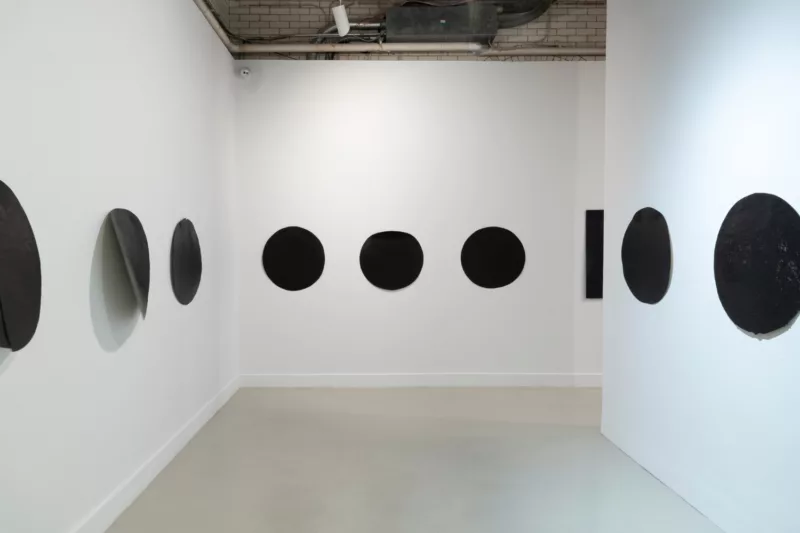
Photograph courtesy of Sam Fritch; Arcadia University
Monumentality and immersiveness figure prominently in Morris’s work. At the gallery he talked about choosing circles for their universality. His circular works in the show are not perfectly round. An example is a work from August 2008. The dimensions listed in the gallery checklist are “27 5/8 x 28 3/8.” Its height and width are close enough that you perceive it as a circle, but you also see its imperfections. The individualism in this and similar works convey an unexpected poignancy, as if they’ve found their way into existence through a lengthy process.
A large horizontal piece from 1977 with the dimensions 35 3/4″ x 159 1/2” – that’s over 13 feet – is a conundrum. It is imposing and substantial, but also thin and flimsy enough to be affixed to the wall with small magnets. Viewing it in person is like seeing the results of a grand improvisation. The jags and torn edges subvert the rectangle. The interior topography of folds and creases catch the light and cast shadows, evoking everything from an industrial product to Giverny at night.
I found Morris’s work moving and, surprisingly, playful. Several of the circular pieces hang in the back of the gallery behind a floating wall. On first impression I was reminded of the portable escape holes employed by the Looney Tunes Roadrunner that violate the laws of physics. While I was looking at them, several people walked by. The pieces are attached to the wall by hidden paper hinges at the top. The gentlest air currents animated them, sending them wafting in the air and waving after people. I don’t know if that was intentional, but it was an added delight.
Like a conceptual afterimage, Quentin Morris’s work lingers with you after you’ve stopped looking at it. It answers questions we don’t know to ask.
Quentin Morris: Works on Paper is on view at Arcadia University’s Spruance Gallery until September 17, 2023. A screening of “Quentin Morris (2018)” by filmmaker Brice Goldberg followed by a discussion with Goldberg and Morris will take place on September 6th. Check the gallery website for details. In addition, a solo exhibition of Quentin Morris’s paintings and works on paper is scheduled for October at Larry Becker Contemporary Art.
Read more Artblog coverage of Quentin Morris:
“Immersive Blackness – Quentin Morris at Larry Becker Contemporary Art,” by Flora Ward
“Weekly Update – Quentin Morris at Larry Becker,” By Roberta



